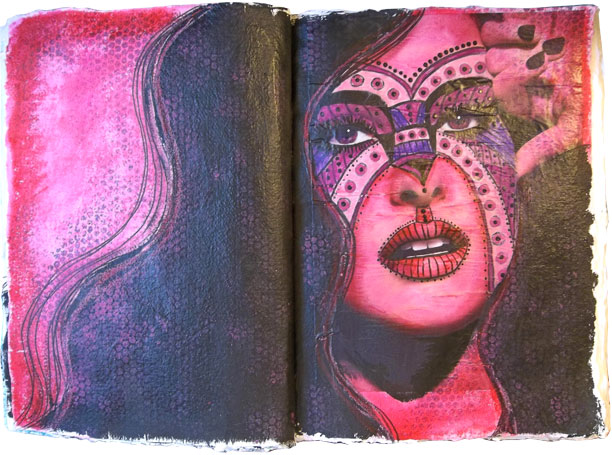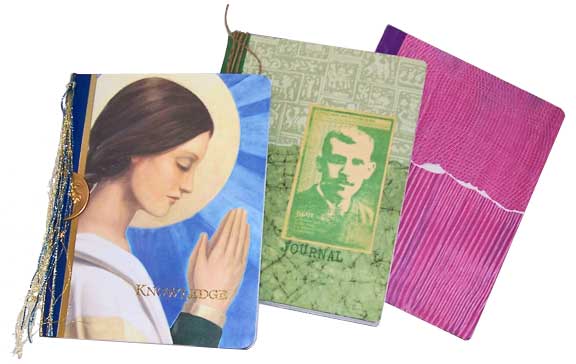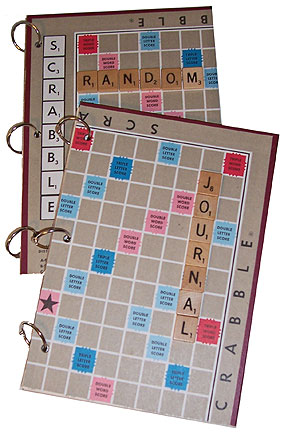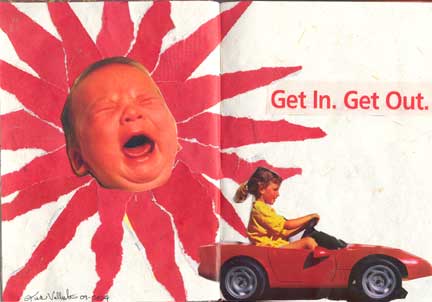
I have a guilty secret to share: I don’t keep a journal.
Periodically, I’ll start a journal, with every intention of working in it once a day, or once a week—and then it turns into once a month, and before I know it, I’ve set the book aside for a year and a half. I must have half a dozen journals here with just a few pages worked. They’re sad, really.
Part of my problem is that I hate to write. I know that sounds stupid coming from someone who writes articles every week or so. I do have a lot to say, I just don’t enjoy the physical act of putting pen to paper. My penmanship is just barely legible. I dislike the look of my own handwriting, which I think makes me completely normal—I read somewhere that over 80% of people polled said they disliked the look of their own handwriting.
Clearly, your average art journal, with its lovely balance of artwork and written word isn’t for me, and may never be. However, I’ve found something that has possibilities for someone like me: gluebooks.
I came upon the word gluebook in someone’s blog, and I wasn’t sure if I was reading a real term or a typo. As always, I jumped over to Dogpile and did a search on the word gluebook. I found a few sites, mostly based in Europe, that had images of books on them, and a little bit of writing about them—very little, actually. I experienced this same thing a couple of years back with decos. There were a handful of sites with images of decos, but not really anything giving a written description of what they are, so I pieced my own description together from the visuals. Well, here we are again…
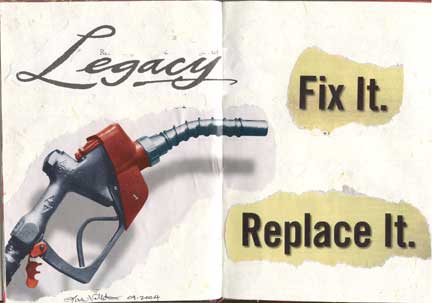
OK, here’s what I learned in my quest for the definitive gluebook description:
Gluebooks are basically collage journals. They do incorporate other types of artwork like drawing and painting, but for the most part, the basis of the gluebook is—surprise—gluing things to the pages. Everyday things, mostly—flyers, receipts, tickets, fast food fallout. These things are the building blocks of the day’s artwork. The visual becomes the description of the day, rather than the written word. There tends to be only minimal writing done in these books, but visually, they do tell a story.
Clearly, this is a type of journal for people who, like me, don’t want to write, but do have something to say about their day.
I started a gluebook of my own, and realized that it seemed familiar to me—and then I remembered that a while back, I started a throw-away collage journal. I even wrote about throw-away collage. I just never connected the journaling part—that the artwork I was making was a reflection of what was happening that day. Gluebooks are an ongoing throw-away collage exercise with a purpose: to illustrate today through everyday items and imagery.
One of the things that jumped out at me about this type of collage work was the use of contemporary images. I’m growing bored with the constant barrage of vintage everything used in collage. I really love the idea of working with modern found objects. In some ways, I’ve come full circle, since when I first started doing altered books, I used images from magazines and ads. Here I am again, looking at those same images in a different way.
True to form, I’m excited enough about this type of journaling to start a group dedicated to it: Gluebooks. If you’d like to exchange ideas on this concept, join up.
An update, a week later:
So far, 165 people have joined the new Gluebooks group. A lot of the discussion has been about defining gluebooks as an art form, and about breaking through barriers to creating. As a group, the feeling is that gluebooks are a healthy way to express everyday thoughts and feelings without taking on the burden of learning endless techniques. All that is required is a book and some glue, and whatever is available to be glued down.
Over the course of the past week, certain questions have recurred:
What exactly is a gluebook?
A gluebook is a type of journal, created by gluing down everyday items such as magazine images, labels, tickets, cash register receipts—whatever paper inspiration falls into the artist’s hands.
If I draw, paint or rubber stamp in my gluebook, is it still a gluebook?
The art police will not come to your door if you choose to use other media in your gluebook. Clearly, since it’s called a gluebook, the basis is that something is being glued. How it is embellished or augmented beyond that is up to each individual artist.
What kind of book should I use for my gluebook?
The answer to this is as varied as the artists who create gluebooks. Some folks are using blank spiral sketchbooks. Some prefer composition books. Others are using whatever blank journals they have at hand. Simply choose a book that is a comfortable size and shape for you, and dive in.
What techniques should I learn before starting my first gluebook?
There are no techniques required. Simply grab your favorite glue, and find something to glue down. Pull things from your newspapers, magazines, junk mail—-everything is gluebook fodder. This is the antithesis of almost every paper craft—there is nothing to learn. Just express yourself.
What’s the difference between gluebooks and altered books?
Gluebooks are basically a type of journal, and usually begin with some sort of blank book—however, if you choose to do your gluebook in a printed book, that’s your own creative choice. Unlike altered books, there are no techniques involved in gluebooks, and no basic supplies required other than some glue and something to be glued down. Which glue, and which things—those are all up to you.
More on gluebooks as I learn…

